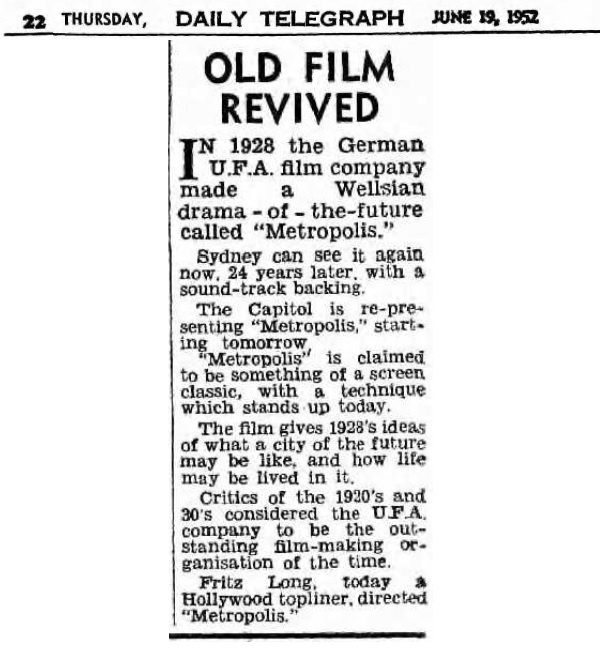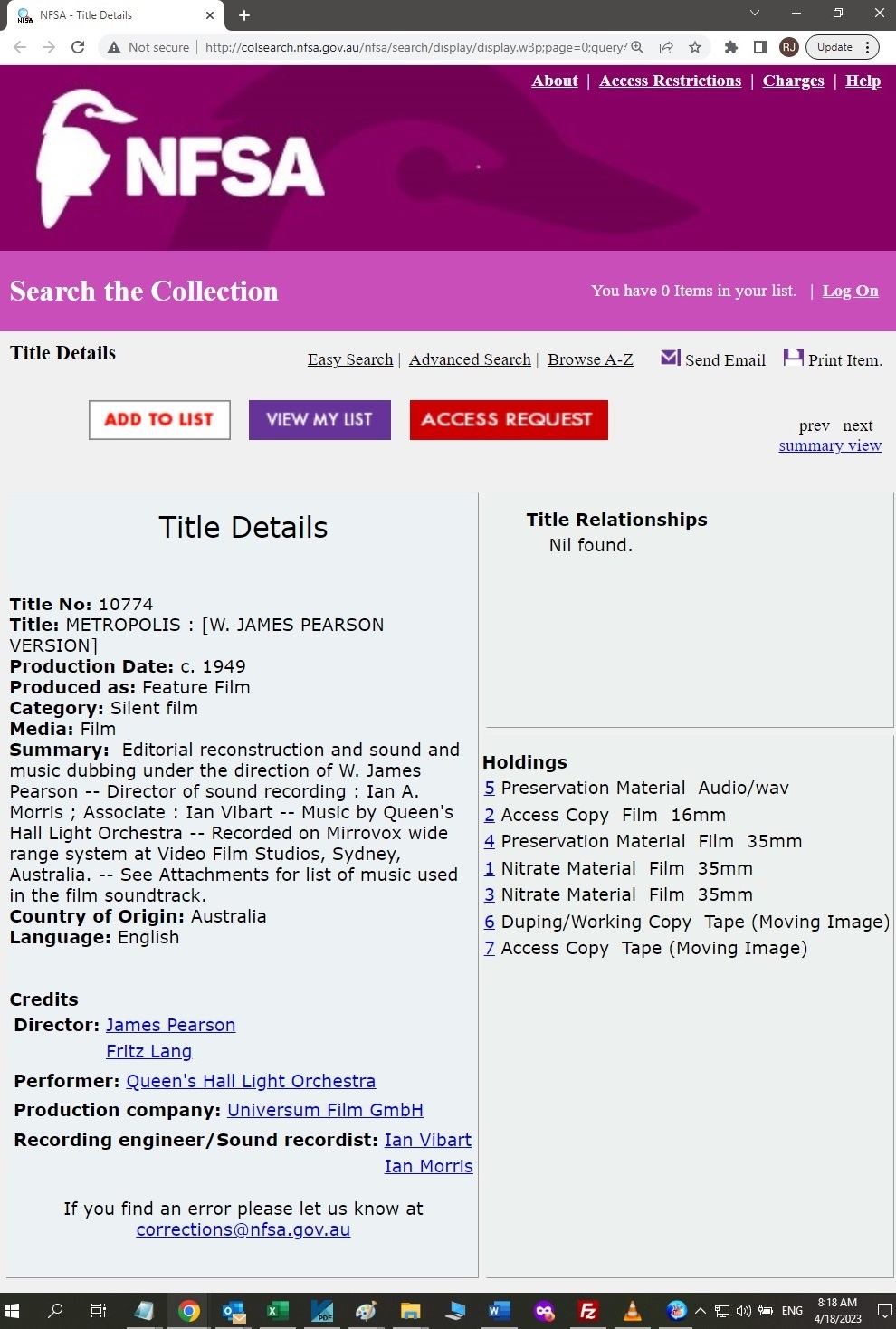What was the involvement of Pearson and the Video Film Studios?
My only guess is that Video Film Studios made the Australian prints from the Associated British copy negative,
and that this was done under Pearson’s direction.
If that’s not what happened, then I’m totally flummoxed.
Actually, it must have been a copy negative, it must have come from Associated British, and it must have been printed in Sydney.
Holding number “3” above is an audio negative,
which is a sure indication that prints were made in Australia.
Despite Pearson’s name featuring prominently in the NFSA listing,
the person credited in the press releases for this June 1952 reissue was Ray Rushmer.
That got me curious.
The very first reference we can find about him dates from 1948.
We learn that
“In 1948 Gordon Wharton of Austral-American arranged for Ray Rushmer to distribute”
Red Sky at Morning under a new title, Escape at Dawn.
By about 1949, Rushmer worked for the Australian branch of Arrow Films.
In 1951 and 1952, he worked for
National Films of N.S.W.
By or before 1954, he founded his own distribution firm, Ray Films.
That is the sum total of the information I can find about Ray Rushmer.
He appeared out of nowhere in 1948
and then he disappeared back into nowhere in 1958.
|
...In mid-1948 a version [of Red Sky at Morning] reduced to 48 minutes was screened in England by a small distributor, Carlyle.
Later, Gordon Wharton, the principal backer of Austral-American,
asked Ray Rushmer, an Australian film distributor, to view the film.
Rushmer proposed several changes and these were implemented by a Sydney film-maker, James Pearson.
Several scenes were deleted, a new opening was shot at Berrima, NSW, and a new ending photographed at sea.
Music and sound effects were also re-recorded.
Re-titled Escape at Dawn, and running for about 55 minutes,
the film now succeeded in being registered as an Australian quota production
and was re-released in England, primarily on the strength of Peter Finch’s name.
No screening, however, seems to have taken place in Australia.
|
So that explains it.
Ray wanted to release Metropolis and so ordered a copy negative from Associated British.
He hired his buddy Pearson to print it, possibly with modifications.
I wonder if the sole modification was editing out the Associated British logo at the beginning
and replacing it with a National Films logo.
So, why is this called the “W. James Pearson Version”?
Because the people who created the index entry didn’t know what else to call it.
A proper name would be the “National Films of N.S.W. Print of the Associated British Pictures Corporation Version.”
When we Google, we discover
“Metropolis Daybill” at VMPF: Vintage Movie Posters Forum.
In November 2016, someone who calls himself
HONDO
started an online discussion about a daybill that he had found (the one you saw a few paragraphs above).
He dug through newspapers and discovered a June 1952 release,
and he concluded that the daybill represented that June 1952 release.
He was correct.
The above article, published in 1951,
mentions that Ray Rushmer re-edited a film called Strong Is the Seed into a TV program called The Farrer Story.
As far as I know, The Farrer Story would not be issued until 1952,
and Wikipedia claims that Ray Films was the distributor in 1952,
but I don’t think Ray Films existed yet.
So, I am confused.
The above article also mentions Castlereagh Films.
Castlereagh Films?
What on earth was Castlereagh Films?
That tells us almost nothing.
What can we learn about National Films of New South Wales?
Its address was
City Tattersalls Chambers,
198-200 Pitt Street,
Sydney NSW. Ah. Getting somewhere.
The general manager was a
Gerald D. Tayler, who had an interest in silent films.
We learn that National Films of N.S.W. specialized in
revivals and reissues, and that it had contracts with producers/distributors in Britain, the US, and continental Europe.
Tellingly, the nitrate Metropolis materials at the NFSA are in a collection named
“DOROTHY TAYLER.”
The Boxoffice article above mentioned that two reels’ worth of footage were eliminated.
Really? Two reels would probably be 16 or 20 minutes,
and yet the film was the same length as the Associated British edition, just over 8,500'.
Commentary was added????? There’s no indication of that.
Rushmer’s press releases were exaggerations.
Typical showbiz. So typical.
HONDO found some press releases published in Sydney’s The Sun for the seven-day run.

Stretch printing is duplicating every second frame —
sometimes every third frame, rarely every fourth frame, but almost always every second frame.
This is done to slow the action down when shown on sound projectors, which run at an unadjustable 24fps.
Silent projectors were driven by variable-speed pulleys.
At the extreme low end, the pulleys would run the film at about 14fps,
at the other extreme, they would run the film at about 32fps.
(Please do not try to run a machine at 32fps.
As an experiment, I did that for just two seconds and nearly suffered a heart attack.
I’m lucky I didn’t destroy the entire mechanism.)
Sound projectors are direct-drive with single-phase AC motors
and so, with the rarest exceptions, the speed is locked at 24fps,
which is too fast for some silent films.
So, next time you watch a silent movie and the motion is ridiculously speeded up,
that might be the fault of sound projection.
A lot of silent films are extremely fast, though, no matter how much you turn down the speed.
There were reasons for that... but, oh gawd, I’m tired. Enough.
We are now faced with two possibilities.
Only two possibilities.
Not less than two possibilities.
Not more than two possibilities.
We are faced with exactly two possibilities:
POSSIBILITY NUMBER ONE: Ray Rushmer told the truth.
POSSIBILITY NUMBER TWO: Ray Rushmer lied.
We are in a position to discredit POSSIBILITY NUMBER ONE.
Ray Rushmer most definitely did NOT stretch print Metropolis.
Why do I say that?
This is why I say that:
Curtain times: 10:45, 12:35, 4:10, 7:20.
Ghosts on the Loose is 67 minutes.
The Floorwalker is 21 minutes.
The total so far is 88 minutes.
The Associated British edition of Metropolis was a little above 94 minutes and it was not stretch printed.
The curtain times would seem to make no sense at all unless that first curtain time was for only one of the three attractions.
If we test that assumption, everything else falls into place.
The following curtain times are for the full package of all three attractions.
Thus:
| 10:45 to 12:20 |
Metropolis |
| 12:35 to 12:56 |
The Floorwalker |
| 12:56 to 02:03 |
Ghosts on the Loose |
| 02:03 to 03:38 |
Metropolis |
| 04:10 to 04:31 |
The Floorwalker |
| 04:31 to 05:38 |
Ghosts on the Loose |
| 05:38 to 07:13 |
Metropolis |
| 07:20 to 07:41 |
The Floorwalker |
| 07:41 to 08:48 |
Ghosts on the Loose |
| 08:48 to 10:33 |
Metropolis |
And that is the ONLY way I can think of to make sense of the published curtain times.
It works, but it only works if Metropolis were not stretch printed.

Capitol, 13 Campbell Street, Sydney, NSW
“Painstakingly rephotographed” is a peculiar foreign term of obscure origin and uncertain meaning.
A possible English translation is “paid a lab to make a duplicate.”
Yet even that would have been untrue.
What played at the Capitol was a print from a copy negative imported from London.
I just did my own search, and I located this little press release:

Sydney Daily Telegraph
Ray Rushmer claimed that he found an old print.
He claimed that he abridged it by about 16 or 20 minutes.
He claimed that he made a stretched duplicate negative of it.
He claimed that he hired firms to add music and sound effects and narration.
False claims all.
This is showbiz, baby; why tell the truth if you can spout preposterous rubbish instead?
|








